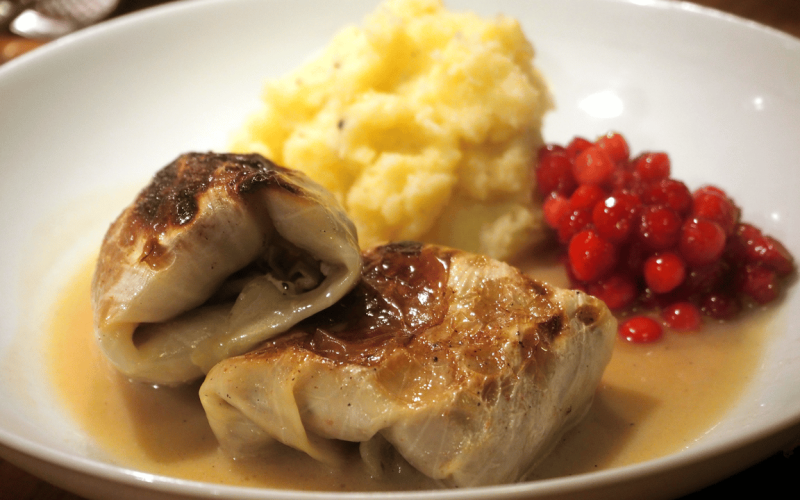Because of Sweden’s huge north-south region there have dependably been local contrasts in Swedish cooking.
Generally, in the far North, meats, for example, reindeer, and other (semi-) amusement dishes were consumed, some of which have their roots in the Sami society, while crisp vegetables have assumed a bigger part in the South.
Numerous customary dishes utilize basic, differentiating flavors, for example, the conventional dish of meatballs and tan cream sauce with tart, impactful lingonberry jam (somewhat comparative in taste to cranberry sauce).
Swedes have customarily been extremely open to remote impacts, going from French cooking amid the seventeenth and eighteenth century, to the sushi and bistro latte of today.
Swedish food could be portrayed as based on civilized dairy items, fresh and delicate (regularly sugared) breads, berries and stone products of the soil, meat, pork and fish. Potatoes are frequently served as a side dish, regularly bubbled.
Swedish food has a colossal mixture of breads of diverse shapes and sizes, made of rye, wheat, oat, white, dull, acrid batter, entire grain; delicate flatbreads and crispbreads. There are numerous sweetened bread sorts and some utilization flavors.
Numerous meat dishes, particularly meatballs are presented with lingonberry jam. Tree grown foods soups with high consistency, in the same way as rose hip soup and blueberry soup (blåbärssoppa) served hot or icy, are commonplace of Swedish cooking.
Margarine and margarine are the essential fat sources, albeit olive oil is getting to be more prominent. Sweden’s baked good convention offers a mixture of yeast buns, treats, bread rolls and cakes; a hefty portion of them in an extremely sugary style and regularly consumed with espresso (fika) are hugely mainstream in Sweden.
Swedish conventional dishes, some of which are numerous several years old, others maybe a century or less, are still an exceptionally essential piece of Swedish ordinary suppers, regardless of the way that advanced Swedish cooking embraces numerous global dishes.
Universally, the most famous Swedish culinary convention is the smorgasbord and, at Christmas, the julbord, including admirably referred to Swedish dishes, for example, gravlax and meatballs.
In Sweden, generally, Thursday has been soup day on the grounds that the servants had a large portion of the vacation day and soup was not difficult to get ready ahead of time.
A standout amongst the most conventional Swedish soups, artsoppa is still served in numerous restaurants and family units each Thursday, a convention since the medieval times.
Artsoppa is a yellow pea soup, served together with hotcakes. This is a basic dinner, a thick soup, essentially comprising of bubbled yellow peas, a little onion, salt and little bits of pork. It is regularly presented with mustard and took after by slender flapjacks (see pannkakor).
The Swedish Armed Forces additionally serve their recruits pea soup and flapjacks each Thursday. Potatoes are consumed year-round as the primary wellspring of starches, and are a staple in numerous customary dishes.
Not until the most recent 50 years have pasta or rice get to be regular on the supper table. There are a few various types of potatoes: the most acknowledged is the new potato, a potato which matures in right on time summer, and is appreciated at the customary mid-summer feast.
New potatoes at midsommer are presented with salted herring, chives, harsh cream, and the first strawberries of the year are generally served as treat.
The most profoundly respected mushroom in Sweden is the chanterelle, which is viewed as a delicacy. The chanterelle is normally served as a side dish together with steaks, or broiled with onions and sauce served on an open sandwich.
Kaldomarare Swedish cabbage rolls loaded with minced pork meat, and now and again rice. They are generally consumed with bubbled potatoes, sauce, and lingonberry jam. Kaldomarare likewise famous in Denmark and in Finland, where they are referred to in Finnish as kaalikaaryle (plural kaalikaaryleet).
The dish is viewed as an assortment of the dolma, normal in Eastern Mediterranean nations. In the wake of losing the Battle of Poltava in 1709 Charles XII of Sweden fled to the city of Bender, in Moldavia, then controlled by his associate, the Sultan of the Ottoman Empire.
Charles XII put in more than five years in the Ottoman Empire, attempting to persuade the Sultan to help him crush the Russians. When he at long last came back to Sweden in 1715, he was trailed by a percentage of the Ottoman lenders from whom he had acquired cash from to fund his wars.
The banks existed in Stockholm until 1732, and amid this time it is in all likelihood that the dolma was presented in Sweden. The principal known Swedish formula for Oriental dolmas was incorporated in a renowned Swedish cookbook composed by Cajsa Warg, in 1765.
At the end of the formula, Ms Warg recommended that the individuals who couldn’t bear the cost of vine leaves could utilize preboiled cabbage leaves within their spot.
In Sweden “Kaldolmens dag” (Day of the Cabbage Roll) is praised on 30 November, the passing day of Charles XII of Sweden and since the 1930s a day checked by Nazi signs, with the reason expressed by its initiators to hail the multifaceted Swedish social legacy including national images with worker foundation.
It is masterminded by “Kaldolmens vanner” (Friends of the Cabbage Roll).
Ingredients
- 1 head cabbage
- 1 glass cooked rice
- 1 lb ground incline pork
- 1 teaspoon salt
- 1/2 teaspoon ground allspice
- 1 egg
- 1/4 teaspoon salt
- 2 tablespoons liquefied spread
- 1/2 mug light cream
- 1 icy cooked potato, ground
- 1 lb ground hamburger
- 1 medium onion, cleaved
- 1/2 teaspoon pepper
- 1/2 teaspoon sugar
- 3 tablespoons flour
- 1/4 mug spread (or more)
- 1 tablespoon flour
Process
- Wash cabbage and uproot any harmed external leaves, remove center.
- Bring an extensive pot of water to bubbling.
- Add cabbage to shrivel leaves while planning stuffing.
- Turn off high temperature under cabbage, combine potato, rice, meats, onion, the 1 teaspoon salt, pepper, allspice, sugar, and egg.
- Separate leaves from cabbage as they shrivel and channel:.
- Return cabbage to water to wither internal takes off.
- Shape stuffing into elliptical patties and place on center end of cabbage leaf.
- Overlay over sides of leaf somewhat and move up, tucking in sides of leaf if conceivable.
- It might be important to affix moves with toothpicks, if utilized, they ought to be uprooted before setting comes in heating dish.
- Blend 3 tablespoons flour and the 1/4 teaspoon salt and move cabbage leaves in mixture; tan in expansive skillet.
- Uproot cabbage moves as they are seared and place in an expansive, level, lubed heating dish.
- Spread dish with aluminum foil.
- Warm over to 300 degrees.
- Prepare 1/2 hours seasoning oftentimes with the 2 tablespoons dissolved spread.
- Expel preparing dish from stove and spot cabbage moves on a warm platter.
- Blend the 1 tablespoon flour and cream in a little container.
- Include the fluid from preparing dish: Cook and mix over respectably low hotness until thickened.
- Season to taste.
- Spill sauce over cabbage moves before serving.








